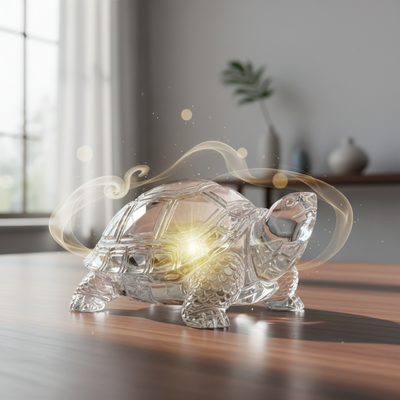Can you put a chair in your bedroom according to Feng Shui? The answer is absolutely yes, but there's an important catch: where you place it, what style you pick, and how you use it really matter. When you choose and position a chair thoughtfully, it can greatly improve your bedroom's energy, or Qi, creating a peaceful and supportive corner. However, if you place a chair poorly or ignore it, it can become a source of stuck and negative energy, called Sha Chi.
This guide will teach you everything you need to know about bedroom chairs. We'll go beyond basic rules to explore the deeper ideas behind them. You'll learn the secrets of proper placement, how to pick a style that matches your energy needs, and how to avoid common mistakes. By the end, you'll know how to turn your bedroom chair from a potential problem into a powerful Feng Shui tool.
The Feng Shui Answer

In Feng Shui, no piece of furniture is naturally "good" or "bad." Its energy impact depends on how it's used and how it fits with the space around it. A chair, which is designed to hold human energy, has strong potential in the bedroom sanctuary. It can either become a source of support or attract chaos. Understanding this balance is the first step to making it work for you.
Support and Peace
A well-placed chair can act like a symbolic "mountain" of support in your life. It provides a stable, grounding presence in the room. This chair becomes a personal sanctuary—a special space for quiet, Yin activities that are perfect for the bedroom. This is where you can read, meditate, or simply sit quietly before sleep. It builds calm, restorative energy that supports the main purpose of the room: rest. Think of it as a gentle anchor in your personal safe space, keeping you steady.
Mess and Disorder
The biggest mistake we see is letting the bedroom chair become a "mess magnet." It becomes the place where clothes, bags, laptops, and random items pile up. When this happens, the chair stops being a seat and becomes a pile of unfinished tasks. This buildup creates stuck energy, blocks the flow of Qi, and serves as a constant visual reminder of chores and responsibilities, which goes against the restful atmosphere a bedroom needs.
The negative effects of a messy chair are serious:
* It creates visual stress and makes you feel overwhelmed.
* It blocks the natural flow of life-force energy (Qi) throughout the room.
* It represents putting things off and unfinished tasks, which can affect your subconscious mind.
* It can collect dust and stagnant energy, possibly affecting air quality and health.
5 Golden Placement Rules
Now that you understand the "why," let's focus on the "how." These five golden rules give you a clear, practical framework for placing your chair to ensure it creates positive energy. Follow this checklist for immediate results in your own space.
1. Use Command Position
The Command Position is the spot in a room where you can see the door without being directly in line with it. While your bed should always be in the main command position, a chair can be placed in a secondary one. The best location is in a corner that is diagonal to the bedroom door. Sitting here gives you a wide view of the room and its entrance. This placement subconsciously removes vulnerability (no one can sneak up on you), creating a deep sense of security, control, and relaxation.
2. Avoid Direct Lines
Energy, or Qi, moves through a room like water; it flows too quickly and harshly in straight lines. Placing a chair directly facing the bed can create confrontational energy, as if someone is watching you, which disrupts peaceful sleep. Similarly, placing a chair with its back directly to the door creates a sense of vulnerability and unease. You should also avoid placing a chair in a way that blocks the path from the bed to the door. This can create subconscious anxiety similar to the "coffin position" (where the bed lines up with the door), making you feel trapped.
3. Create a Special Zone
Give your chair a clear purpose. Prevent it from becoming a vague, multi-purpose object by creating a defined zone around it. This doesn't need to be fancy. Simply placing the chair on a small, round rug, with a floor lamp and a tiny side table, establishes its purpose. This setup clearly says, "This is a reading corner," or "This is my meditation spot." By creating a dedicated zone, you contain and build its specific, calm energy, making it much less likely to attract clutter.
4. Keep Paths Clear
This rule is both practical and energetic. Your chair should never block major walkways in the bedroom. Make sure you can walk around it easily and that it doesn't block access to your closet, dresser drawers, or the window. In Feng Shui, blocked pathways represent obstacles in your life's journey. Physically bumping into a chair every time you need to get dressed is frustrating; energetically, it creates a constant, low-level blockage that disrupts the smooth flow of Qi and your daily routine.
5. Think About the View
Finally, consider what you see when you sit in the chair. The view from your seat directly affects your state of mind. Ideally, the chair should face something pleasant and calming. This could be a window with a view of nature, a beautiful piece of art, or simply a clean, organized, and peaceful part of your bedroom. Avoid positioning the chair to face a messy desk, a tangle of electronic wires, a television, or a large mirror, as these can bring stressful or overly active energy.
Understanding Chair Styles
Beyond placement, the physical form of the chair itself carries a distinct energy signature. Choosing a style that matches your intention for the space is an expert-level Feng Shui adjustment that can have a deep impact. Here's how to understand the energy of different chair styles.
The Sturdy Armchair
A classic, upholstered armchair with solid arms is a powerful Feng Shui tool. It embodies the energy of the "armchair embrace," offering a sense of being held and protected.
- Energy Qualities: It represents stability, security, and steady support. The arms act like a hug, creating a contained and safe space. Its solid form makes it an excellent "mountain" to ground a corner of the room, adding a feeling of permanence and strength.
- Best for: Creating a dedicated reading corner or a space for deep reflection and journaling. It's ideal for larger bedrooms where its weight can anchor the room's energy.
The Open-Weave Chair
Chairs made from materials like rattan, wicker, or cane, as well as mid-century modern designs with thin, visible legs, have a much different energetic feel. Their design is light and airy.
- Energy Qualities: The open structure allows light and Qi to flow through and under the chair, preventing energy from becoming trapped. This makes the room feel more spacious and less heavy. It promotes movement and flexibility.
- Best for: Smaller bedrooms where a solid armchair would feel overwhelming and heavy. It's a perfect choice for maintaining a sense of openness and flow.
The Office Desk Chair
Bringing a work chair into the bedroom is one of the most challenging Feng Shui situations. These chairs are designed for activity and mental focus—the very definition of active, bright "Yang" energy.
- Energy Qualities: This Yang energy directly conflicts with the calm, restful "Yin" energy needed for a sanctuary of sleep. The wheels on many office chairs also represent instability and a life that is "on the go," which is not good for rest.
- Strong Recommendation: If a desk in the bedroom is unavoidable, reduce the energetic clash. Choose a chair that feels less corporate. After work hours, use a beautiful screen or a cloth to cover the entire workspace, visually and energetically separating it from your rest area.
| Good for Bedroom Desk Chair | Avoid for Bedroom Desk Chair |
|---|---|
| Soft, upholstered seat | Hard plastic or mesh |
| Fixed legs if possible | Wheels (represents instability) |
| Warm, natural materials | Cold, metallic finishes |
| Can be visually "softened" | Looks overly corporate/industrial |
The Chaise Lounge
The chaise lounge is perhaps the most energetically aligned chair for a bedroom, as its only purpose is relaxation and rest. It is the perfect example of restful energy.
- Energy Qualities: It embodies leisure, luxury, and restorative rest. Its long form encourages you to recline and release tension. It sends a powerful message that this room is a place to unwind and recharge.

- Best for: Larger bedrooms that have the space to accommodate its size without feeling cramped. It can act as a beautiful and highly functional secondary relaxation spot, separate from the bed.
From Mess to Calm: A Real Example
Theoretical knowledge is valuable, but seeing principles in action provides true clarity. At our consultancy, we frequently encounter the "problem chair," and its transformation is often one of the most impactful changes we make. This case study shows how simple adjustments to a single chair can shift the entire energy of a room.
The Client's Problem
We were consulted by Sarah, a busy professional who felt her bedroom had become a source of stress. "It feels stuck," she told us. Despite investing in beautiful furniture, she had trouble falling asleep and felt a persistent, low-level anxiety whenever she was in the room. The main culprit was immediately obvious: a handsome armchair in the corner that was completely invisible beneath a mountain of clothes, work bags, and books. To make matters worse, it was positioned to face her bed directly.
Our Feng Shui Assessment
The QI FLOW team began our assessment by mapping the energy flow in the room. We identified several critical issues centered around the chair. First, the mountain of clutter on it was creating a massive pocket of stagnant energy (Sha Chi). This "stuck" energy was mirroring her own feelings about her life. Second, its direct, confrontational alignment with the bed was creating an aggressive energy, subconsciously making her feel "watched" and judged as she tried to rest. It was a physical representation of her never-ending to-do list.
The Action Plan
Our recommended solution was simple, inexpensive, and targeted. We created a three-step action plan to relocate, repurpose, and re-energize the chair and the space.
- The Great Clear-Out: The first and most vital step was to have Sarah completely clear the chair. We guided her in finding proper, organized homes for every single item. This act alone was a powerful release of stagnant energy.
- The Relocation: We moved the chair from its confrontational position to the far corner of the room, diagonal to the door. This placed it in a secondary Command Position, giving it—and her, when sitting in it—a sense of security and a pleasant view out the nearby window.
- Creating the Corner: To give the chair a new, single purpose, we had her add a warm-light floor lamp behind it and a small wooden stool beside it, designated to hold only a cup of tea and the book she was currently reading. It was now officially a "Relaxation Zone."
The Result
The change was immediate and deep. Within a week of implementing these changes, Sarah reported a "noticeable shift" in the atmosphere. The room felt lighter, calmer, and more welcoming. Her sleep improved dramatically. She told us, "It's like the room can finally breathe. I'm sleeping better, and I actually use the chair to unwind now instead of seeing it as another chore." This case perfectly shows how a few mindful changes to a single piece of furniture, like a chair in bedroom feng shui, can transform the entire feel of a space.
Common Mistakes to Avoid
As you integrate a chair into your bedroom, be mindful of these common pitfalls. Avoiding them is just as important as implementing the positive changes.
- The "Anything But a Seat" Chair: This is the number one rule. The moment your chair becomes a default shelf for clutter, it begins to generate negative energy. Be disciplined about keeping it clear. If it has a purpose, use it for that purpose.
- Broken or Wobbly Chairs: Never keep broken, wobbly, or damaged furniture in your home, especially the bedroom. On a symbolic level, this represents broken health, unstable finances, or rocky relationships. Repair it or replace it immediately.
- Antique Chairs with Unknown History: Be careful with antiques. Furniture can retain the energy of previous owners. If a piece has a heavy, sad, or unsettling feeling, trust your intuition. If you choose to keep an antique, perform a space-clearing ritual, such as smudging with sage or leaving it in the sun, to cleanse its energetic history.
- Exercise Equipment as a "Chair": A stationary bike or weight bench is the ultimate source of active Yang energy. Do not store or use this equipment in your bedroom. It introduces the energy of stress, exertion, and work into your sanctuary of rest, severely disrupting its core function.
Your Chair, Your Sanctuary
Ultimately, the goal of chair in bedroom feng shui is not to follow a rigid set of rules but to consciously create a space that feels supportive, calm, and deeply restful to you. The chair is a powerful tool in this process. By understanding its energetic potential and applying these principles, you can ensure it contributes positively to your personal sanctuary.
Remember the key takeaways:
* Placement is key: Aim for a command position and ensure clear pathways.
* Purpose is everything: Define your chair's role as a seat for rest, not a shelf for clutter.
* Style matters: Choose a chair whose physical form supports the calm, Yin function of a bedroom.
Use this knowledge to make intentional choices. Your bedroom chair shouldn't be an afterthought; it should be a carefully selected ally in your quest for peace and rejuvenation.








0 comments